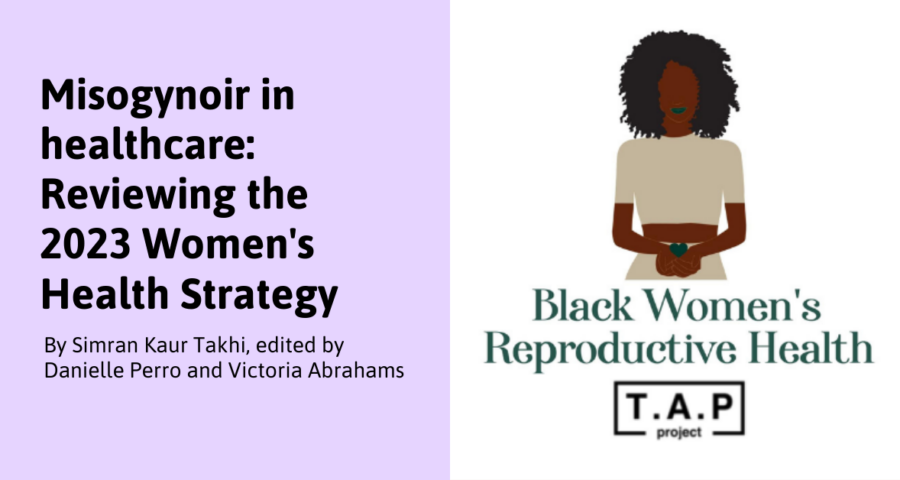Written by Simran Kaur Takhi and edited by Danielle Perro and Victoria Abrahams, on behalf of the Black Women’s Reproductive Health Project
July 22nd saw the publication of the Women’s Health Strategy (WHS) for England, the government’s 125 page document addressing how the health outcomes of women and girls aim to be improved over the next decade. Ambitious? Yes, but also a much anticipated read which many of us hoped would serve justice in the face of what we already know: that women’s health issues and the system that claims to support them exists within a context of historic inequality, prejudice, and as we will discuss in this piece, misogynoir.
Writing a proposal to strategically respond to the plethora of problems women go through when experiencing and (if they get this far) accessing healthcare is no mean feat as a result of the outdated beliefs and deeply rooted gender biases which underpin health inequalities (e.g. hysteria and denial of women’s pain, respectively) and meagre NHS funding and capacity. However, we were disappointed by the strategy’s failure to appreciate and acknowledge the unique challenges and experiences faced by Black women when accessing healthcare in this country.
Research has consistently illustrated instances where Black women bear the brunt of health inequalities. Black women in London have been shown to experience up to three times the rate of long-term conditions such as chronic pain, anxiety, hypertension and osteoarthritis when compared to other ethnic groups. Black women are four times more likely to die from childbirth compared with White women in the UK. These women also experience some of the worst sexual and reproductive health outcomes in the UK. And whilst the WHS stated a mission to “right the wrongs” within healthcare, we must ask how the government plans on achieving this mission whilst the existence and impact of systematic racism – one of the biggest wrongs underpinning racial health inequalities – was not mentioned on any of the 125 pages of the document.
The barriers Black women encounter when receiving good quality physical and mental healthcare are rooted in factors relating to culture, stigma and misogynoir, and yet the strategy does not acknowledge that such unique factors are inextricably linked to the kinds of health disparities we see today. The lived experiences of Black women accessing healthcare have been collected and analysed, thanks to grassroots organisations which serve to illustrate the roots of healthcare disparities such as the organisation Five x More in their survey of 1350 Black and Black mixed women, which found that 54% of women faced challenges with healthcare professionals during their maternity care, with the majority of women attributing challenges as a result of race-based discrimination e.g. being labelled as “dramatic” during an epidural.
The WHS acknowledges women not feeling listened to by healthcare professionals, stating that more research in this area will be commissioned through the NIHR. While there is optimism around the increased funding, we hope that as a result of such funding, more actionable solutions are put forward to eliminate race-based discrimination within the healthcare encounter.
Whilst the complexities of the unique challenges faced by Black women in accessing healthcare are illustrated by the lived experiences of Black women, it is plausible that such experiences were not actively sought during the call for evidence into the WHS. The strategy was developed on the back of a listening exercise which generated 100,000 responses from English women, however the report fails to provide an ethnic breakdown of the respondents. Considering that the health inequalities women face are rooted in systemic racism, coupled with the consistent issue of an absence of ethnic diversity within health researchmeans that the strategy’s choice to exclude demographic information can be brought into scrutiny.
Structural racism and the repercussions on healthcare have profound impacts on Black women’s physical and mental health. However, we must acknowledge the unique, racialised factors which prevent Black women from engaging with the health care system in the first place.
The Black Womens Reproductive Health report (BWRHR) is the first report of its kind to have documented the experiences of 165 Black British people with female reproductive systems in relation to accessing menstrual – reproductive healthcare. The report included a literature review of first person blog entries, interviews and magazine articles which found that Black women often explained observing their mothers experiencing severe menstrual pain and discomfort as children.
This, combined with the fact that, by many accounts, mothers would not openly acknowledge their pain led to an internalisation of a “grin and bear” approach to health issues and discomfort. The cultural messages passed on within specific communities, particularly those which are experienced at a young age, inadvertently shapes health outcomes and thus demands tailored solutions.
What the strategy does well is emphasise a life course approach to tackling issues, referring to an understanding of the changing health and care needs of women and girls across their lives. This life course approach is particularly welcome when you consider issues surrounding menstruation e.g., stigma and negative cultural messages experienced in childhood, and their power to cast a shadow on the adult experience.
The exampled lack of acknowledgement of historical and structural racism means that the strategy as it stands can only serve people for whom racialised treatment doesn’t exist. If there is no acknowledgement of the unique factors which shape healthcare outcomes for Black women, (i.e. misogynoir and dismissal of pain), there can be no unique solutions posed which could holistically and robustly improve the lives of women and girls. For instance, the BWRH highlighted the power of specialist, Black women peer support initiatives/spaces as being a vital tool in supporting Black women’s menstrual health education and advocacy. In contrast, the WHS is another example of a piece of research succumbing to the one-size-fits-all approach – treating women as one homogenised group at a disadvantage due to their gender alone.
With this strategy, the importance of understanding factors which shape health outcomes right from cradle to grave has been cemented. But when a 10-year strategy claims to have the power to impact the lives of women and girls on a monumental scale whilst failing to acknowledge systemic racism – an experience tainting the lives of every woman of colour – you know that there’s a much deeper problem. As a critical call for action in the UK, proponents of the BWRH have used its preliminary findings to author key recommendations to support Black women’s menstrual and reproductive health. Whilst the strategy is a springboard towards the beginnings of meaningful change we must remember the voices of those the strategy left behind.

Simran works as a mental health researcher, contributing towards making services more recovery-orientated. She has a keen interest in the stories and lived experiences of marginalised communities – particularly those of women navigating their menstrual and reproductive health. She can be found tweeting @Marquee__Moon.

